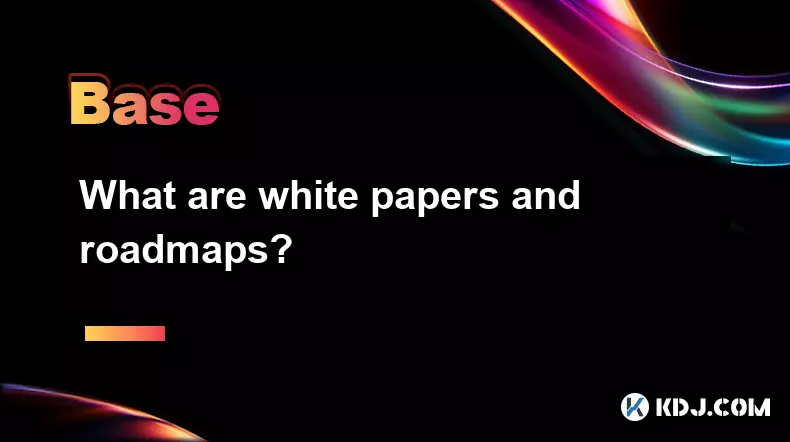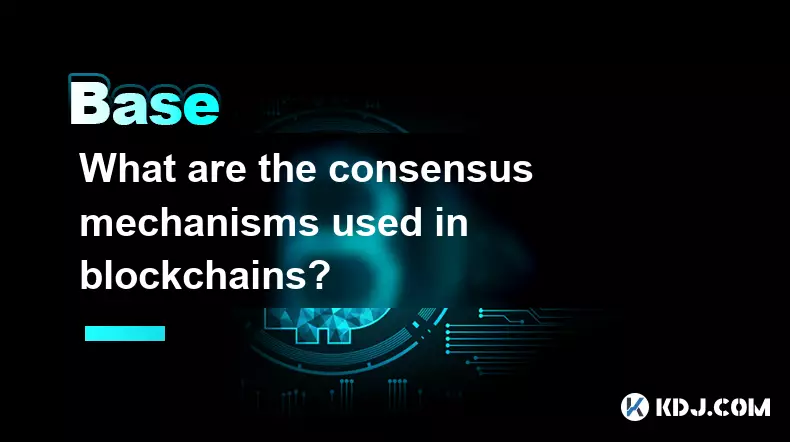-
 bitcoin
bitcoin $109667.069529 USD
-3.03% -
 ethereum
ethereum $3936.685804 USD
-4.07% -
 tether
tether $1.000493 USD
0.01% -
 xrp
xrp $2.771823 USD
-4.74% -
 bnb
bnb $957.805027 USD
-5.34% -
 solana
solana $196.735100 USD
-6.68% -
 usd-coin
usd-coin $0.999727 USD
-0.01% -
 dogecoin
dogecoin $0.227355 USD
-5.12% -
 tron
tron $0.335205 USD
-0.81% -
 cardano
cardano $0.779256 USD
-3.59% -
 ethena-usde
ethena-usde $0.999900 USD
-0.06% -
 hyperliquid
hyperliquid $42.492095 USD
-6.61% -
 chainlink
chainlink $20.501853 USD
-4.34% -
 avalanche
avalanche $28.952606 USD
-11.21% -
 stellar
stellar $0.356038 USD
-3.93%
What are white papers and roadmaps?
A strong crypto white paper details technology, goals, and tokenomics, while a clear roadmap outlines milestones—both are vital for transparency and investor trust.
Sep 23, 2025 at 08:55 pm

Understanding White Papers in the Cryptocurrency Industry
1. A white paper in the crypto space is a detailed document that outlines the purpose, technology, and goals of a blockchain project. It serves as a foundational resource for potential investors, developers, and users to understand what the project aims to achieve.
2. These documents typically include technical specifications such as consensus mechanisms, tokenomics, network architecture, and cryptographic methods used within the system. They also explain how the native cryptocurrency functions within the ecosystem.
3. A well-written white paper builds credibility by demonstrating transparency and deep technical insight into the project’s design and implementation. Projects like Bitcoin and Ethereum gained early traction largely due to the clarity and innovation presented in their original white papers.
4. Investors often rely on white papers to assess the feasibility and originality of a project. Scrutinizing elements such as problem-solution alignment, team expertise, and scalability can help determine whether a project has long-term viability.
5. Many fraudulent or poorly conceived projects have been exposed simply because their white papers lacked coherence, contained plagiarized content, or made unrealistic promises without technical backing.
The Role of Roadmaps in Blockchain Development
1. A roadmap in the cryptocurrency industry is a strategic timeline that outlines key milestones a project intends to achieve over a defined period. It provides stakeholders with visibility into development progress and future objectives.
2. Roadmaps commonly include phases such as mainnet launch, exchange listings, partnerships, feature rollouts, audits, and community growth targets. Each phase is usually assigned a projected timeframe, helping teams stay accountable.
3. Transparent roadmaps foster trust among the community by showing consistent progress and clear direction. When updates are shared regularly against the roadmap, it strengthens confidence in the team's execution capabilities.
4. Some projects adopt flexible roadmaps that evolve based on user feedback, market conditions, or technological challenges. While adaptability is valuable, frequent unexplained changes may raise concerns about planning stability.
5. Community-driven initiatives often use interactive roadmaps where contributors can vote on upcoming features or prioritize development tasks, enhancing engagement and decentralization principles.
Differentiating Between White Papers and Roadmaps
1. While both documents are essential, a white paper focuses on the conceptual and technical foundation of a project, whereas a roadmap emphasizes time-bound execution and deliverables.
2. The white paper answers questions like 'What problem does this solve?' and 'How does the technology work?', while the roadmap addresses 'When will features be released?' and 'What comes next in development?'
3. Investors should review both documents together to form a complete picture of a project’s vision and its ability to deliver on that vision. A strong white paper with a vague or missing roadmap may indicate poor planning.
4. Conversely, an ambitious roadmap without a solid underlying white paper might suggest hype-driven marketing rather than substance. Alignment between the two increases the likelihood of sustainable success.
5. In mature projects, updated versions of both documents are released periodically—revised white papers reflect protocol upgrades, and adjusted roadmaps incorporate new priorities or delayed timelines.
Frequently Asked Questions
What makes a cryptocurrency white paper trustworthy?A trustworthy white paper includes clear explanations of the technology, realistic goals, cited sources, diagrams illustrating system architecture, and information about the development team. Avoid those with excessive jargon, unclear token distribution models, or copied content.
Can a project succeed without a published roadmap?While possible, especially in early-stage research projects, most successful blockchain ventures publish roadmaps to maintain transparency. Lack of a roadmap may hinder investor confidence and make it difficult to track progress.
Do all blockchain projects need a white paper?Yes, nearly all legitimate blockchain initiatives release a white paper. It is considered standard practice for communicating core ideas and attracting technical and financial support. Exceptions are rare and usually limited to internal enterprise solutions not seeking public investment.
How often should a project update its roadmap?Regular updates—quarterly or biannually—are common. Significant shifts in development status, delays, or major achievements warrant immediate revisions. Frequent communication around roadmap changes helps maintain community trust.
Disclaimer:info@kdj.com
The information provided is not trading advice. kdj.com does not assume any responsibility for any investments made based on the information provided in this article. Cryptocurrencies are highly volatile and it is highly recommended that you invest with caution after thorough research!
If you believe that the content used on this website infringes your copyright, please contact us immediately (info@kdj.com) and we will delete it promptly.
- Swift, Ethereum, and Layer 2: Bridging Traditional Finance with Blockchain Innovation
- 2025-09-27 06:25:12
- Dubai Fund, TikTok, and US Business: A New Era?
- 2025-09-27 06:45:13
- XPL Surge After Launch Crash: From All-Time High to Recovery?
- 2025-09-27 06:45:13
- Laguna Beach, Tokenizing, and Beauty: A New Era?
- 2025-09-27 06:25:12
- Hester Peirce, NFTs, and the SEC's Crypto Future: A Shift in Tone?
- 2025-09-27 06:50:01
- Circle, Rollback, and Stablecoins: A New Era of Crypto Security?
- 2025-09-27 06:50:01
Related knowledge

What are some common methods of cryptocurrency market manipulation?
Sep 27,2025 at 02:55am
Wash Trading and Its Impact on Market Perception1. Wash trading involves an individual or entity simultaneously buying and selling the same cryptocurr...

How do I read a cryptocurrency whitepaper?
Sep 27,2025 at 05:54am
Understanding the Structure of a Cryptocurrency Whitepaper1. Begin by identifying the executive summary, which outlines the project’s core vision and ...

Can I recover lost cryptocurrency?
Sep 25,2025 at 08:18am
Understanding the Nature of Cryptocurrency Loss1. Cryptocurrency operates on decentralized networks, meaning there is no central authority to reverse ...

How can I earn passive income from cryptocurrency?
Sep 23,2025 at 10:18am
Staking Cryptocurrencies for Regular Returns1. Many blockchain networks operate on a proof-of-stake (PoS) consensus mechanism, allowing users to earn ...

What are gas fees in cryptocurrency transactions?
Sep 26,2025 at 02:00am
Understanding Gas Fees in Blockchain Transactions1. Gas fees are payments made by users to compensate for the computing energy required to process and...

What are the consensus mechanisms used in blockchains?
Sep 24,2025 at 10:00am
Proof of Work and Its Role in Blockchain Security1. Proof of Work (PoW) is one of the earliest consensus mechanisms, first implemented by Bitcoin. Min...

What are some common methods of cryptocurrency market manipulation?
Sep 27,2025 at 02:55am
Wash Trading and Its Impact on Market Perception1. Wash trading involves an individual or entity simultaneously buying and selling the same cryptocurr...

How do I read a cryptocurrency whitepaper?
Sep 27,2025 at 05:54am
Understanding the Structure of a Cryptocurrency Whitepaper1. Begin by identifying the executive summary, which outlines the project’s core vision and ...

Can I recover lost cryptocurrency?
Sep 25,2025 at 08:18am
Understanding the Nature of Cryptocurrency Loss1. Cryptocurrency operates on decentralized networks, meaning there is no central authority to reverse ...

How can I earn passive income from cryptocurrency?
Sep 23,2025 at 10:18am
Staking Cryptocurrencies for Regular Returns1. Many blockchain networks operate on a proof-of-stake (PoS) consensus mechanism, allowing users to earn ...

What are gas fees in cryptocurrency transactions?
Sep 26,2025 at 02:00am
Understanding Gas Fees in Blockchain Transactions1. Gas fees are payments made by users to compensate for the computing energy required to process and...

What are the consensus mechanisms used in blockchains?
Sep 24,2025 at 10:00am
Proof of Work and Its Role in Blockchain Security1. Proof of Work (PoW) is one of the earliest consensus mechanisms, first implemented by Bitcoin. Min...
See all articles










































































